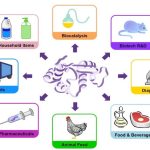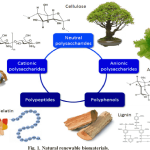Biopesticides, a contraction of ‘biological pesticides’, include several types of pest management intervention: through predatory, parasitic, or chemical relationships. The term has been associated historically with [biological control] – and by implication – the manipulation of living organisms. Regulatory positions can be influenced by public perceptions, thus:
· in the EU, biopesticides have been defined as “a form of pesticide based on micro-organisms or natural products”.
· the US EPA states that they “include naturally occurring substances that control pests (biochemical pesticides), microorganisms that control pests (microbial pesticides), and pesticidal substances produced by plants containing added genetic material (plant-incorporated protectants) or PIPs”.
They are obtained from organisms including plants, bacteria and other microbes, fungi, nematodes, etc. They are often important components of integrated pest management (IPM) programmes, and have received much practical attention as substitutes to synthetic chemical plant protection products (PPPs).
Types
Biopesticides can be classified into these classes-
· Microbial pesticides which consist of bacteria, entomopathogenic fungi or viruses (and sometimes includes the metabolites that bacteria or fungi produce). Entomopathogenic nematodes are also often classed as microbial pesticides, even though they are multi-cellular.[4][5][6]
· Bio-derived chemicals. Four groups are in commercial use: pyrethrum, rotenone, neem oil, and various essential oilsare naturally occurring substances that control (or monitor in the case of pheromones) pests and microbial diseases.
· Plant-incorporated protectants (PIPs) have genetic material from other species incorporated into their genetic material (i.e. GM crops). Their use is controversial, especially in many European countries.
· RNAi pesticides, some of which are topical and some of which are absorbed by the crop.
Biopesticides have usually no known function in photosynthesis, growth or other basic aspects of plant physiology. Instead, they are active against biological pests. Many chemical compounds have been identified that are produced by plants to protect them from pests so they are called antifeedants. These materials are biodegradable and renewable alternatives, which can be economical for practical use. Organic farming systems embraces this approach to pest control.
RNA
RNA interference is under study for possible use as a spray-on insecticide by multiple companies, including Monsanto, Syngenta, and Bayer. Such sprays do not modify the genome of the target plant. The RNA could be modified to maintain its effectiveness as target species evolve tolerance to the original. RNA is a relatively fragile molecule that generally degrades within days or weeks of application. Monsanto estimated costs to be on the order of $5/acre.
RNAi has been used to target weeds that tolerate Monsanto’s Roundup herbicide. RNAi mixed with a silicone surfactant that let the RNA molecules enter air-exchange holes in the plant’s surface that disrupted the gene for tolerance, affecting it long enough to let the herbicide work. This strategy would allow the continued use of glyphosate-based herbicides, but would not per se assist a herbicide rotation strategy that relied on alternating Roundup with others.
They can be made with enough precision to kill some insect species, while not harming others. Monsanto is also developing an RNA spray to kill potato beetles One challenge is to make it linger on the plant for a week, even if it’s raining. The Potato beetle has become resistant to more than 60 conventional insecticides.
Monsanto lobbied the U.S. EPA to exempt RNAi pesticide products from any specific regulations (beyond those that apply to all pesticides) and be exempted from rodent toxicity, allergenicity and residual environmental testing. In 2014 an EPA advisory group found little evidence of a risk to people from eating RNA.
However, in 2012, the Australian Safe Food Foundation posited that the RNA trigger designed to change the starch content of wheat might interfere with the gene for a human liver enzyme. Supporters countered that RNA does not appear to make it past human saliva or stomach acids. The US National Honey Bee Advisory Board told EPA that using RNAi would put natural systems at “the epitome of risk”. The beekeepers cautioned that pollinators could be hurt by unintended effects and that the genomes of many insects are still unknown. Other unassessed risks include ecological (given the need for sustained presence for herbicide and other applications) and the possible for RNA drift across species boundaries.
Monsanto has invested in multiple companies for their RNA expertise, including Beeologics (for RNA that kills a parasitic mite that infests hives and for manufacturing technology) and Preceres (nanoparticle lipidoid coatings) and licensed technology from Alnylam and Tekmira. In 2012 Syngenta acquired Devgen, a European RNA partner. Startup Forrest Innovations is investigating RNAi as a solution to citrus greening disease that in 2014 caused 22 percent of oranges in Florida to fall off the trees.
Examples
Bacillus thuringiensis, a bacteria capable of causing disease of Lepidoptera, Coleoptera and Diptera, is a well-known insecticide example. The toxin from B. thuringiensis (Bt toxin) has been incorporated directly into plants through the use of genetic engineering. The use of Bt Toxin is particularly controversial. Its manufacturers claim it has little effect on other organisms, and is more environmentally friendly than synthetic pesticides.
Other microbial control agents include products based on:
· entomopathogenic fungi (e.g. Beauveria bassiana, Isaria fumosorosea, Lecanicillium and Metarhizium spp.),
· plant disease control agents: include Trichoderma spp. and Ampelomyces quisqualis (a hyper-parasite of grape powdery mildew); Bacillus subtilis is also used to control plant pathogens.
· beneficial nematodes attacking insect (e.g. Steinernema feltiae) or slug (e.g. Phasmarhabditis hermaphrodita) pests
· entomopathogenic viruses (e.g.. Cydia pomonella granulovirus).
· weeds and rodents have also been controlled with microbial agents.
Various naturally occurring materials, including fungal and plant extracts, have been described as biopesticides. Products in this category include:
· Insect pheromones and other semiochemicals
· Fermentation products such as Spinosad (a macro-cyclic lactone)
· Chitosan: a plant in the presence of this product will naturally induce systemic resistance (ISR) to allow the plant to defend itself against disease, pathogens and pests.[11]
· Biopesticides may include natural plant-derived products, which include alkaloids, terpenoids, phenolics and other secondary chemicals. Certain vegetable oils such as canola oil are known to have pesticidal properties[citation needed]. Products based on extracts of plants such as garlic have now been registered in the EU and elsewhere.


